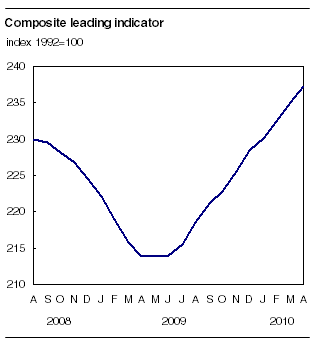Common menu bar links
Leading indicators
Archived Content
Information identified as archived is provided for reference, research or recordkeeping purposes. It is not subject to the Government of Canada Web Standards and has not been altered or updated since it was archived. Please "contact us" to request a format other than those available.
Related subjects
The composite leading index rose 0.9% in April, continuing a stretch of 11 straight increases averaging 1.0% a month. Overall, 8 of the 10 components advanced, led by housing and the stock market, while 1 was unchanged and 1 fell.

The housing index rose 0.8%, as higher housing starts outweighed lower house sales. The increase in housing starts, however, was not enough to reverse the downward trend of unsold vacant units. Existing home sales softened early in 2010 after reaching a record high late in 2009. Furniture and appliance sales continued to strengthen, while demand for other durable goods fell 0.7%.
Manufacturing continued to recover. New orders rose for the third straight month, their longest string of increases since March 2008. Higher sales drove the advance in the ratio of shipments to inventories, which hit its highest level since February 2008. Firms used the recovery in demand and output to raise productivity, as both the average workweek and employment in factories remained little changed.
The leading indicator for the United States kept pace with Canada, rising 0.9%. The labour market continued to recover in response to gains in consumer spending and exports and an upturn in inventories.
Available on CANSIM: table 377-0003.
Definitions, data sources and methods: survey number 1601.
This release will be reprinted in the June 2010 issue of Canadian Economic Observer, Vol. 23, no. 6 (11-010-X, free). For more information on the economy, consult the Canadian Economic Observer.
For more information, or to enquire about the concepts, methods or data quality of this release, contact Philip Cross (613-951-9162; ceo@statcan.gc.ca), Current Economic Analysis Group.
Table 1
| November 2009 | December 2009 | January 2010 | February 2010 | March 2010 | April 2010 | Last month of data available | |
|---|---|---|---|---|---|---|---|
| % change | |||||||
| Composite leading indicator (1992=100) | 225.6 | 228.5 | 230.1 | 232.4 | 235.1 | 237.2 | 0.9 |
| Housing index (1992=100)1 | 130.4 | 134.0 | 135.8 | 138.2 | 138.4 | 139.5 | 0.8 |
| Business and personal services employment ('000) | 2,884 | 2,906 | 2,918 | 2,932 | 2,950 | 2,960 | 0.3 |
| S&P/TSX stock price index (1975=1,000) | 11,082 | 11,273 | 11,319 | 11,366 | 11,591 | 11,744 | 1.3 |
| Money supply, M1 ($ millions, 1992)2 | 205,641 | 207,903 | 209,751 | 211,630 | 213,288 | 214,589 | 0.6 |
| US Conference Board leading indicator (1992=100)3 | 124.9 | 125.9 | 127.1 | 128.2 | 129.2 | 130.4 | 0.9 |
| Manufacturing | |||||||
| Average workweek (hours) | 37.0 | 36.9 | 36.7 | 36.5 | 36.5 | 36.5 | 0.0 |
| New orders, durables ($ millions, 1992)4 | 18,266 | 19,790 | 19,521 | 20,704 | 21,296 | 21,342 | 0.2 |
| Shipments/inventories of finished goods4 | 1.63 | 1.66 | 1.70 | 1.73 | 1.77 | 1.80 | 0.035 |
| Retail trade | |||||||
| Furniture and appliance sales ($ millions, 1992)4 | 2,836 | 2,845 | 2,847 | 2,879 | 2,919 | 2,952 | 1.1 |
| Other durable goods sales ($ millions, 1992)4 | 9,762 | 9,911 | 10,008 | 10,077 | 10,068 | 9,999 | -0.7 |
| Unsmoothed composite leading indicator | 232.2 | 233.7 | 233.2 | 237.1 | 239.3 | 242.5 | 1.3 |

